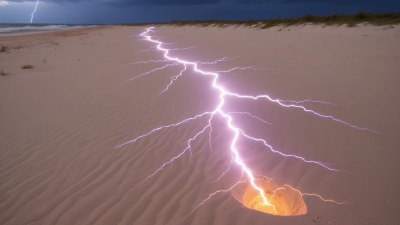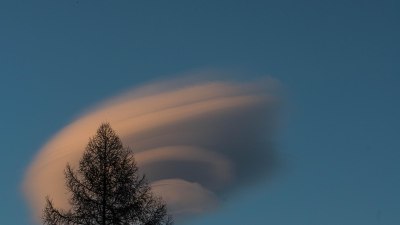How Lightning Creates Glass in Sand
Discover the fascinating process of how lightning transforms sand into stunning glass formations.

This image was created with the assistance of Freepik
Lightning is one of nature's most awe-inspiring phenomena, producing not only a spectacular light show but also causing some unexpected geological transformations. One such transformation is the creation of glass from sand, a process that is both fascinating and scientifically intriguing. This article explores how lightning strikes can lead to the formation of natural glass, commonly known as fulgurite, and the various factors involved in this remarkable process.
The Composition of Sand
To understand how lightning can create glass, it's essential first to consider the composition of sand. Sand is primarily made up of silicon dioxide (SiO2), the same material that makes up most of Earth's crust. Under normal conditions, sand grains are loose and angular, with varying particle sizes and shapes. When lightning strikes the ground, it delivers an immense amount of energy, creating conditions that can drastically alter the physical state of sand.
The Nature of Lightning
Lightning is a powerful electrical discharge that occurs during storms. A lightning bolt can reach temperatures of around 30,000 degrees Fahrenheit (about 16,600 degrees Celsius) and can carry millions of volts of electricity. This energy is released in a fraction of a second, resulting in an explosive burst of heat and light. When lightning strikes sand, the intense heat can cause the silicon dioxide in the sand to melt and fuse together, forming glass.
The Formation of Fulgurite
The glass created by lightning is known as fulgurite. Fulgurites are typically tube-like structures with a hollow core, resembling a root or a glassy cobweb. The shape is a result of the pathway the lightning takes as it travels through the ground. The exterior of a fulgurite is usually rough and sandy, while the interior is smooth and glassy. These structures can vary in size, ranging from a few inches to several feet long, depending on the intensity and duration of the lightning strike.
Conditions for Fulgurite Formation
Several conditions are necessary for the formation of fulgurite. First, the sand must be of a high purity, meaning it should contain a significant amount of silicon dioxide with minimal impurities. Second, the lightning strike must occur at a relatively close distance to the sand, allowing the energy to be transferred efficiently. Third, the moisture content in the sand can also influence fulgurite formation; damp sand is more conducive to glass creation as it can better conduct electricity. These factors combined determine whether a lightning strike will yield fulgurite or merely scorch the surface of the sand.
Investigating Fulgurite
Scientists frequently study fulgurite to understand the conditions and processes involved in its formation. Researchers have noted that the unique glassy texture of fulgurites can provide insights into the temperatures and pressures experienced during the lightning strike. Additionally, the presence of trapped air bubbles within the glass can reveal information about the surrounding environment at the time of the strike. Analyzing these structures allows researchers to learn more about electrical discharges in natural settings and their geological implications.
Significance of Fulgurite
Fulgurite serves not only as an interesting geological formation but also as a record of lightning strikes and their effects on the environment. The study of natural glass formations can be valuable to various scientific fields, including geology, atmospheric sciences, and even materials science. By examining these structures, researchers can gain insights into Earth's electrical activity, sand composition, and the potential for using fulgurites as indicators of past climatic conditions.
Collecting Fulgurite
Fulgurite is often collected by treasure hunters, gem enthusiasts, and curious individuals looking to own a piece of nature's art. When collecting fulgurite, it is essential to follow local laws and regulations to ensure the preservation of these unique natural formations. Because fulgurite is relatively fragile, it's best to handle it carefully to avoid breaking or damaging the glass. Some collectors enjoy incorporating fulgurite into jewelry, artwork, or natural history displays, showcasing its unique and captivating properties.
Preserving Fulgurite
For those fortunate enough to possess fulgurite, proper care and preservation are crucial. The glass can be sensitive to temperature changes and humidity, so keeping it in a stable environment away from direct sunlight is advisable. Ideally, fulgurite should be stored in a display case to protect it from dust and accidental damage. Regularly inspecting and cleaning the glass can help maintain its beauty and integrity over time, allowing future generations to appreciate this incredible natural phenomenon.
Myths and Legends about Lightning and Glass
Fulgurite has long captured the imagination of people, giving rise to various myths and legends. In some cultures, lightning was considered a sign from the gods, and the resulting glass formations were viewed as sacred artifacts. Many ancient civilizations believed that fulgurite held mystical powers, often associating it with healing or protective qualities. These stories reflect humanity's fascination with the connection between nature's phenomena and the miraculous transformations that occur as a result.
Modern Applications of Fulgurite
Scientists are also investigating potential modern applications for fulgurite. Researchers are exploring the use of fulgurite as a material for various technologies due to its unique physical properties. For example, fulgurite has shown potential in the field of semiconductors and electronics, where the glassy structure and electrical conductivity may be advantageous. These applications highlight how an understanding of natural processes can lead to innovative solutions in science and technology.
The process of lightning creating glass in sand is a remarkable phenomenon that illustrates the power of nature and the beauty of geological transformations. Fulgurites serve as a unique reminder of lightning's impact on our environment, illuminating the complexities of electrical discharges and their effects on the Earth. Whether viewed as natural art, a scientific curiosity, or a piece of our cultural heritage, fulgurite captivates our imagination and serves as a testament to the fascinating world we inhabit.











